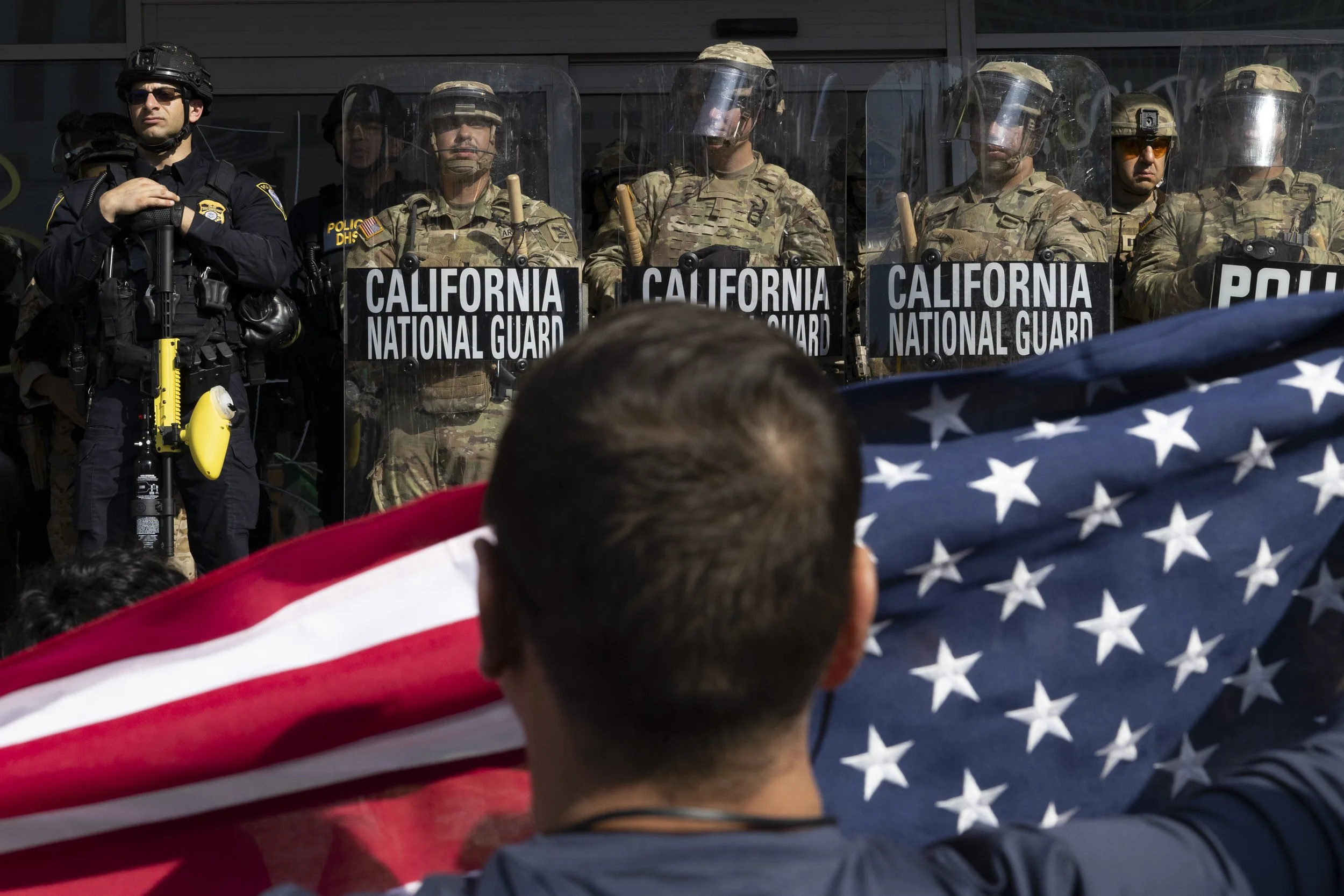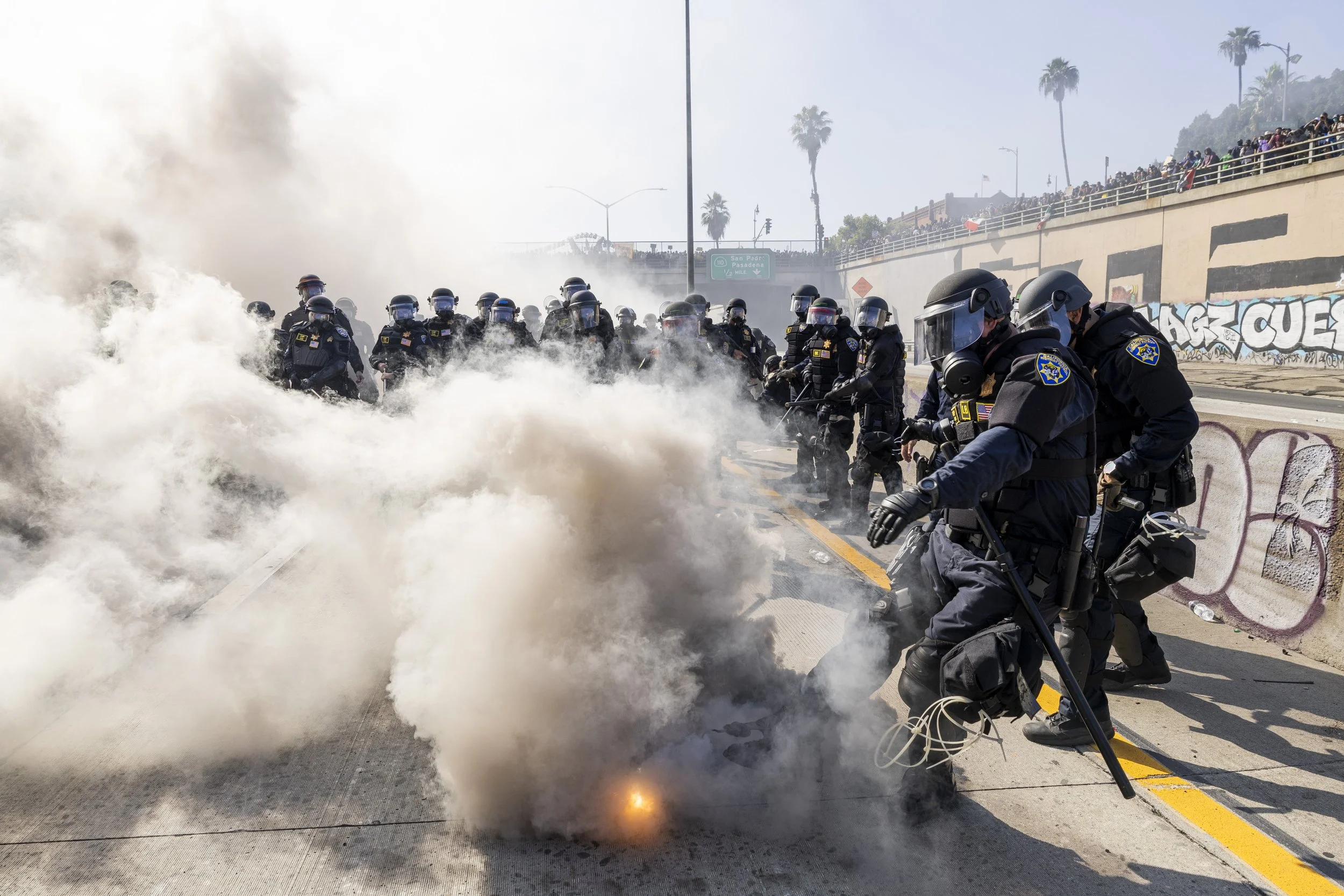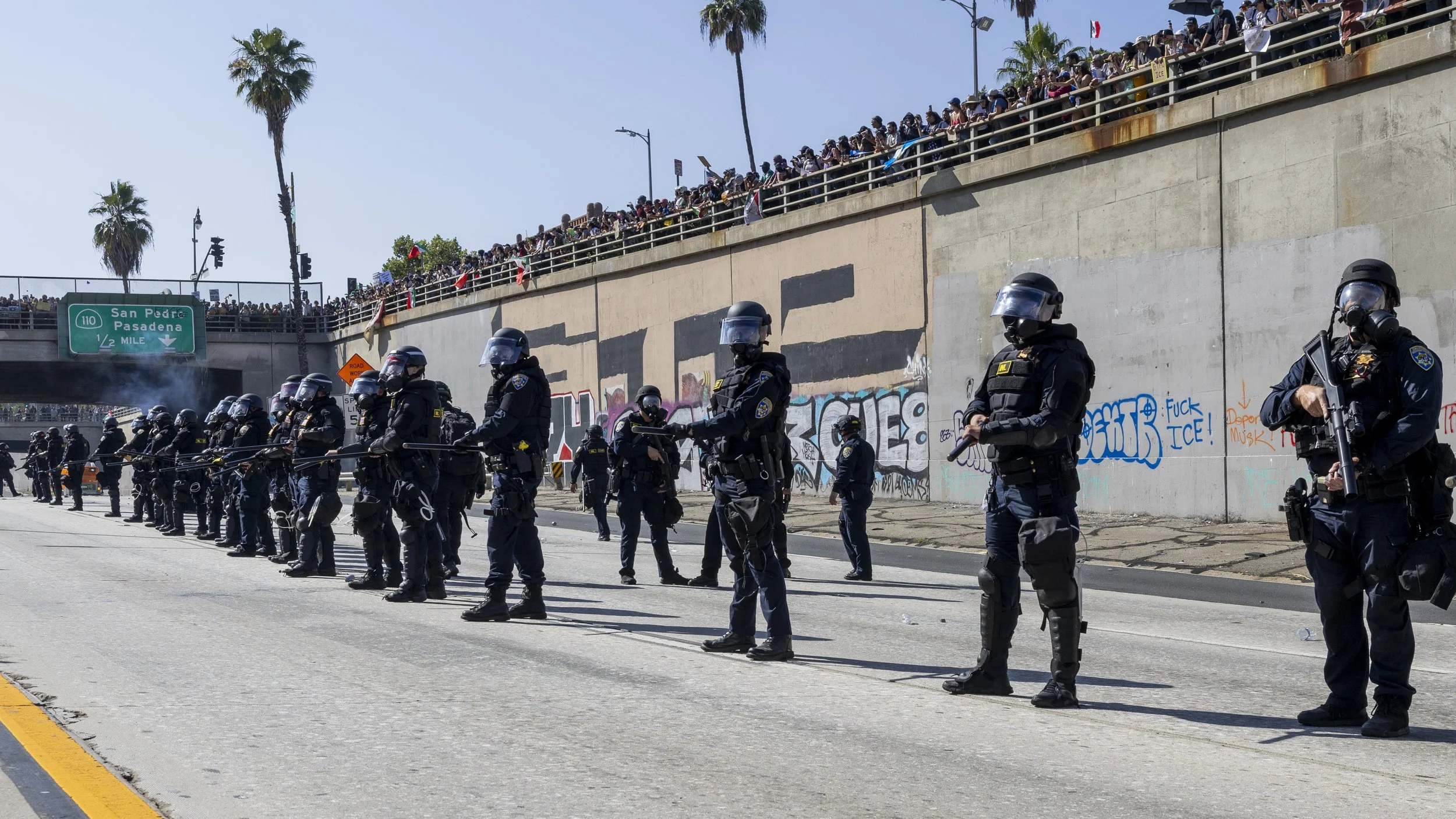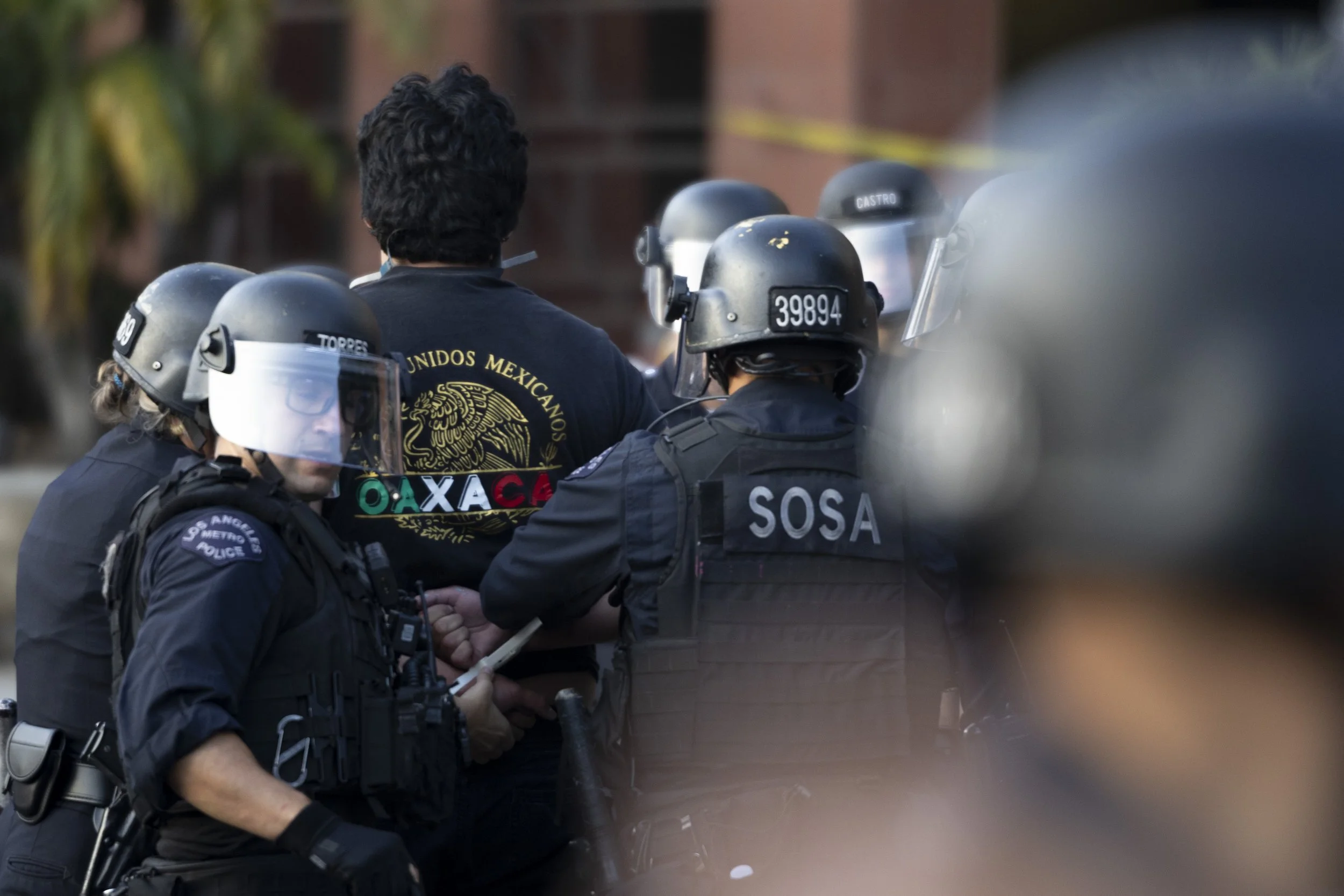Religious groups, peaceful protesters, federal forces and some rioters take to streets in days 2-4 of demonstrations; LAPD pending Professional Standards review
































The stretch of Alameda Street before the detention center, a designated spot for protesting within recent days, was blocked off completely, closed “indefinitely” by Los Angeles police. A cohort of clergy and laity in vestment stood before the police line. They held hands and sang hymns. Way up above, detainees inside the center held up signs and flashed lights on and off in the windows.
At noon on Monday, this 100-person crowd protesting Immigrations and Customs Enforcement (ICE) raids largely kept the peace—even described by the Los Angeles Police Department (LAPD) as a “small, peaceful demonstration.” As white police shuttles drove past the LAPD line, a couple demonstrators rushed up, kicked the cars and pelted them with water bottles.
Other members of the group immediately reprimanded them and yelled for them to stop and remain peaceful.
“No violence!” they screamed.
The preceding 72 hours of protest had seen a wide range of resistance activity. Evidence of energetic discourse lined the streets: charred car parts, streaks of CS gas residue. By the LAPD’s own estimate, the department had fired over 600 rounds of less-than-lethal munitions as of Monday morning.
The department also announced over 160 arrests with charges related to the protests, including failure to disperse, looting, resisting arrest, vandalism, assault with a deadly weapon, and attempted murder with a Molotov cocktail.
More charges are coming, the department warns: LAPD is “continuing to review body-worn video and other evidence related to the incident and will work with prosecutorial partners to seek appropriate charges for those involved in criminal activity.”
But in the same statement, LAPD announced the department itself will be investigated by the LAPD Professional Standards Bureau over alleged “excessive force and other issues related to LAPD actions during the protest.”
“What I’ve seen is lots of unprovoked attacks by the police,” said Joshua Fleshman, a defense attorney and protester. “They’ve been hitting people sort of indiscriminately with rubber bullets.”
“Really, I’ve seen nothing but peaceful demonstration from us all day (Monday), and all the aggression has been coming from the police,” he said.
Within the police-barricaded zone on Alameda Street, already cut off from the public, the federal building’s Loading Dock was guarded by a squadron of personnel from 79th Infantry Brigade Combat Team, members of the California National Guard.
President Donald Trump deployed 2,000 National Guardsmen to Los Angeles on June 7, citing Title 10 of the United States Code. That statute permits the president to summon federal forces when U.S. law isn’t executed properly, or when he perceives rebellion or the threat of rebellion.
“To the extent that protests or acts of violence directly inhibit the execution of the laws, they constitute a form of rebellion against the authority of the Government of the United States,” Trump wrote in a memorandum enacting the deployment.
The memorandum also authorized Defense Secretary Pete Hegseth to deploy additional federal forces as he deems necessary to protect federal property and squash rebellion. On Monday, Hegseth summoned the deployment of 700 Marines from the second Battalion, seventh Marines, first Marine Division to join the National Guard in Los Angeles.
“The activation of the Marines is intended to provide Task Force 51 with adequate numbers of forces to provide continuous coverage of the area in support of the lead federal agency,” read a statement from the U.S. Northern Command on June 9.
The deployment of both federal forces will cost $134 million, the Pentagon’s acting Chief Financial Officer said Tuesday.
On Tuesday, Santa Monica College (SMC) Superintendent and President Dr. Kathry Jeffery said in a statement that the deployment of National Guards, as well as heightened ICE activity in general, has left the college community “alarmed, dismayed, and deeply concerned.”
“Now, more than ever, SMC reaffirms and stands strong behind its commitment to provide a safe and inclusive learning environment for all students, regardless of immigration status, sexuality, gender/gender identity, race, religion, ethnicity, national origin, disability, age, or socio-economic background. Know that we will continue to safeguard your rights and personal information at SMC,” Jeffery said.
Her message also said the college’s Vice President of Academic Affairs has encouraged faculty to “extend flexibility, wherever possible, to those whose attendance and/or participation in final assignments/exams might be impacted by the unprecedented events taking place in the LA area.”
On Monday at around 5:30 p.m., a dense crowd outside the Edward R. Roybal federal building was deemed an unlawful assembly and gradually pushed out by LAPD, Sheriff Department and federal forces. As they had done previously, police used stun grenades to enforce the dispersal.
Guardsmen could be spotted from the top floor of the federal building. Some protesters alleged they were deploying less-than-lethals from above.
Over the next few hours, LAPD pushed the group, adamantly refusing a full dispersal, through Little Tokyo and into the Arts District. While moving through the zone, police would partially cordon the streets and have an immobile standoff with protesters that lasted about half an hour per area. The police continuously deployed stun grenades and rubber bullets.
One protester marched down the police line, reading the names of the officers aloud. After each name, the crowd yelled, “Quit your job!”
Occasional water bottles were tossed from the protesting side. As the other group had earlier, many protesters chastised the throwers: “Stop throwing shit!”
Many members of the group repeatedly chanted the words: “Peaceful protest!”
By 8:30 p.m., Alameda Street was fully cordoned between Traction Avenue and Third Street, enclosing about 50 people. Everybody inside the kettle was detained, including all members of the press.
“I saw the kettle was happening, and I had an opportunity to escape if I had wanted to,” Fleshman said. “And I felt that maybe by being somebody who has a bit of power and privilege, just by virtue of my occupation, maybe being here and being an ally was something that I wanted to do.”
Elsewhere downtown, other protesting groups were engaged in their own clashes with police lines. On San Pedro Street and Second Street, where protesters filled the lanes, police began firing stun grenades in congruence with a dispersal order, while some retaliated with fireworks. The street was cleared around 10 p.m.
In Paramount and neighboring city Compton on June 7, a similar chaotic scene unfolded with cops and protesters squaring up in a commercial area. For hours in the evening, protesters scattered throughout Alondra Boulevard, yelling, playing music, dancing, and sometimes clutching their faces and running when the Sheriff’s Department line by the 710 Freeway deployed tear gas.
Demonstrators set up a makeshift barricade of trash bins and furniture; from behind it, they shot fireworks and shielded from retaliatory flashbangs.
But again, similarly to the other long days of protest, much of the action was immobile, practically stalemate—until the police advanced up Alondra Boulevard at 9 p.m., firing chemical agents and torrents of rubber bullets.
For the next two hours, the sheriff line blocked off Alondra Boulevard along Atlantic Avenue. Protesters who didn’t disperse hid behind cars and kiosks at the nearby gas station to shield from the less-than-lethals. At some point during the night, the gas station, an Ampm, was broken into and ransacked.
Some of the hiders announced they were going to throw Molotov cocktails.
“The Sheriff’s Department is not involved in any federal law enforcement operations,” the department said in a statement on Sunday.
“When federal authorities come under attack and request assistance, we will support them and provide aid. However, this does not mean that we are assisting with their immigration actions or operations; rather, our objective is to protect them from any violent attacks,” the statement continues.
“When Trump sent the federal government in here to conduct raids on L.A., he didn’t understand Los Angeles. He didn’t understand our community supports our immigrants,” Fleshman said.
“He didn’t understand that we’re not going to just sit down and take it.”
The Corsair’s coverage of the Santa Monica-sanctioned immigration forum includes comprehensive advice from lawyers on how to navigate the threat of detainment: https://www.thecorsaironline.com/corsair/2025/3/18/at-hushed-community-forum-santa-monica-mayor-police-chief-promise-sanctum-for-immigrant
